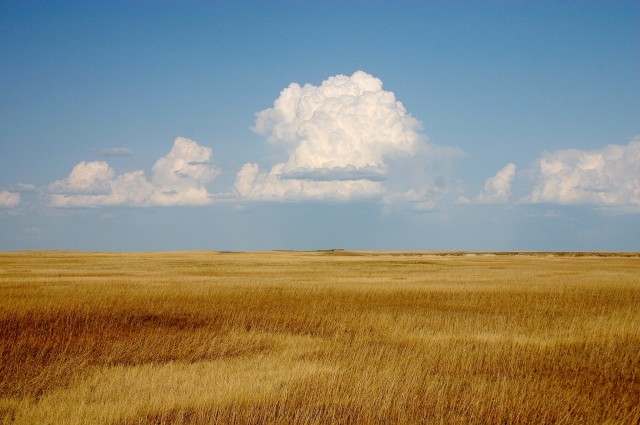prairie
BEFORE NORTH AMERICA was populated by settlers who developed the land, most of the continent was covered by flat grass-covered areas known as prairie, stretching from CANADA to MEXICO. By the beginning of the 21st century, 99 percent of the original prairie had been destroyed. The provinces of Alberta, Saskatchewan, Manitoba, and Ontario are part of Canada's prairie. In the UNITED STATES, prairies are found in NORTH and SOUTH DAKOTA, MINNESOTA, NEBRASKA, IOWA, ILLINOIS, INDIANA, WISCONSIN, KANSAS, MISSOURI, OKLAHOMA, and TEXAS. In South America, prairie land is known as PAMPAS. In Africa, it is called veldt; and in Asia, it is known as STEPPE.
Some 60 different species of grass once could be found among North American prairies. Growth potential seemed almost unlimited because prairie grasses were able to adapt to weather that varied from extreme hot to extreme cold. Prairie grass extended rapidly since it was pollinated by the wind.

Prairie grasses are classified as tall-grass, mixed-grass, short-grass, bunch-grass, mesquite, and tree. The kinds of prairie grass found in an area are dependent on a number of variables, including weather, longitude, latitude, extent of usage, soils, and landforms. Typically, grasses become shorter as the prairie progresses from east to west. Prairie grasses range from eightfoot-tall grasses, such as bluestem, switch grass, and slough grass, to one-half-foot short grasses, such as blue grama, hairy grama, and buffalo grass. Of the six types of prairie grass, tall-grass and mixed-grass regions are the most productive agriculturally. America's wheat belt, which grows abundant amounts of corn, wheat, barley, oats, and rye, is home to such prairie grasses.
The area that extends from southern Manitoba to Missouri to Wisconsin to Illinois to Indiana to Oklahoma and Texas is known as True Prairie. While prairies tend to be relatively flat, knolls, steep bluffs, hills, valleys, and alluvial floodplains exist in this area. Rainfall varies from one prairie section to another. Southern prairies tend to be dry and hot, with numerous shrubs. In the north, prairies are cool and humid. Some 70 percent of all precipitation in the western prairie falls during the growing season.
In the area that extends from Oklahoma to Illinois, for instance, the prairie receives around 40 in (101 cm) of rain each year. In the northeastern section that reaches from Minnesota to Manitoba, some 23 in (58 cm) fall in a given year. Oklahoma prairies may experience as much as 30 in (76 cm) a year, while Nebraska and North Dakota receive 25 in (63 cm) and 20 in (51 cm) per year, respectively. Droughts may occur in the prairies in the summer and fall, making the area vulnerable to fire. Prairie soil and chernozem soil dominate the plains. Both of these dark soils tend to be rich in humus and conducive to plant production.
One prairie area designated as the High Plains stretches from Alberta, Saskatchewan, in Canada to Montana and North Dakota in the United States. Generally flat in the eastern section, the High Plains rise around 10 feet per mile as they reach the foothills of the ROCKY MOUNTAINS. Since much of this land remains uninhabited, pronghorn antelope and mule deer are still abundant. With average rainfall of less than 20 in (50 cm) per year, the short-grass, which is mostly blue and grama, in the High Plains is too dry to provide irrigation for crops or grazing for livestock. The area's river valleys, coulees, and ravines are too steep for farming and are too bare for logging. Taller and thicker grass populates the eastern section of the High Plains, and forbs, which are broad-leaved, flowering shrubs, are plentiful. Riverbeds and wetlands, with numerous lakes, marshes, sloughs, and potholes provide homes for most of the wildlife remaining in the area.
Originally, large animals found in the prairie included American bison, pronghorn antelope, mule deer, white-tailed deer, elk, lynx, grizzly bear, bobcat, fox, cougar, prairie wolf, and coyote. Jackrabbit, cottontail, mice, weasel, badger, prairie dog, shrew, vole, ground squirrel, gopher, skunk, and raccoon were among the smaller animals found in the area. Bird life on the prairies was abundant, including bobolink, pipits, meadowlark, sparrow, grouse, prairie chicken, hawk, eagle, falcon, and vultures. Pelican, crane, heron, sandpiper, swan, geese, and duck were plentiful in prairie marshes. Only small numbers of the original wildlife remain in the prairie. Buffalo, for instance, are now found only on protected reserves.
Despite their sturdy nature, prairies were vulnerable to land development because most immigrants possessed little knowledge of grasslands. Native Americans also frequently destroyed prairie lands to facilitate travel and provide greater security. Fire has also historically presented a major threat to prairies. In the 1930s, prairie recovery efforts emerged, leading to an increased interest among environmentalists, ecologists, and others interested in preserving the integrity of native prairie grasses.